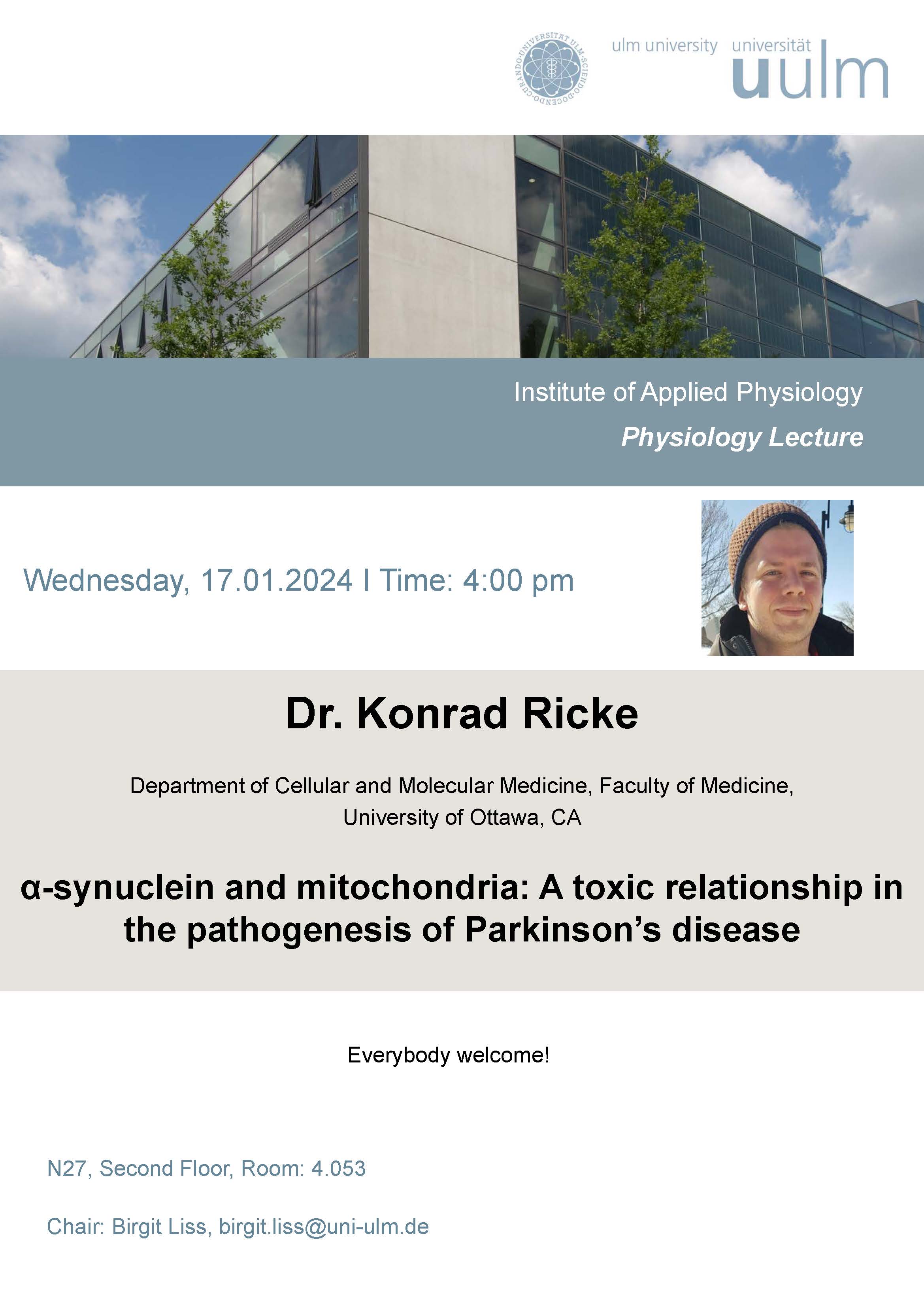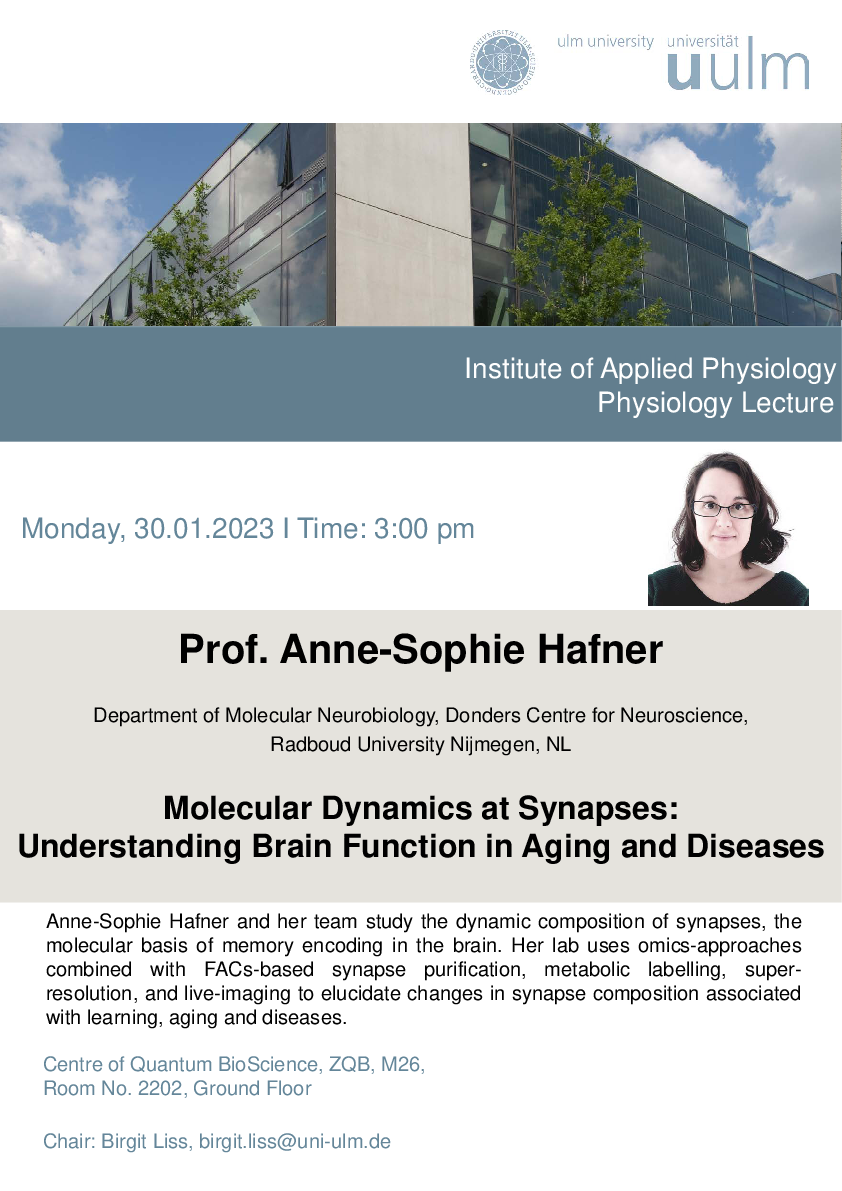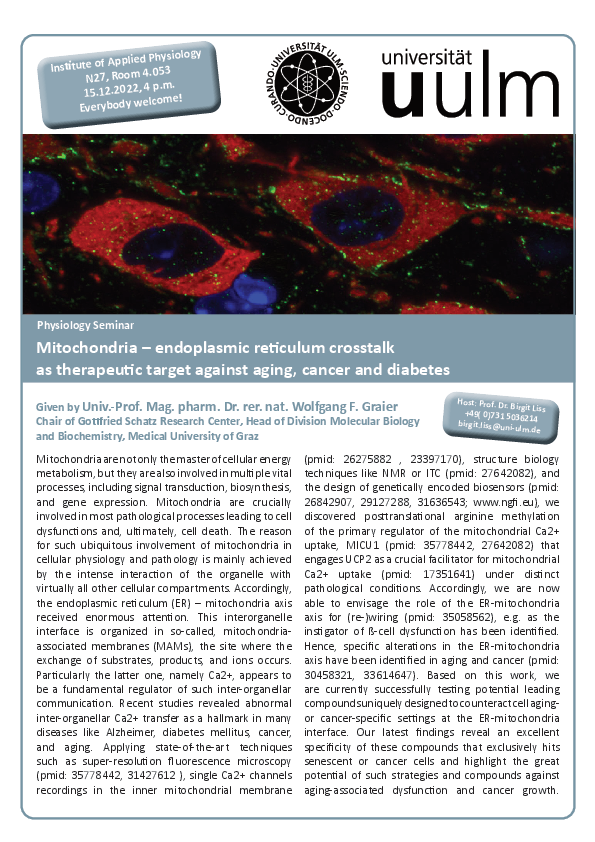Vergangene Physiologie Seminare / Vorträge
Dr. Konrad Ricke
Department of Cellular and Molecular Medicine, Faculty of Medicine, University of Ottawa, CA
Date: 17.01.2024, 4 pm
Location: N27, Room No. 4053
Everybody welcome!
Host: Prof. Dr. Birgit Liss
birgit.liss@uni-ulm.de
Molecular Dynamics at Synapses: Understanding Brain Function in Aging and Diseases
Prof. Anne-Sophie Hafner
Department of Molecular Neurobiology, Donders Centre for Neuroscience, Radboud University Nijmegen, NL
Date: 30.01.2023, 3 pm
Location: Centre of Quantum BioScience, ZQB, M26, Room No. 2202, Ground Floor
Brief description
Anne-Sophie Hafner and her team study the dynamic composition of synapses, the molecular basis of memory encoding in the brain. Anne-Sophie Hafner is most known for unravelling the first presynaptic transcriptome from mature excitatory boutons in the forebrain and demonstrating the abundance of active protein synthesis in all synaptic compartments: postsynapses as well as excitatory and inhibitory presynaptic boutons. Her lab uses omics-approaches combined with FACs-based synapse purification, metabolic labelling, super-resolution, and live-imaging to elucidate changes in synapse composition associated with learning, aging and diseases. The Hafner lab aims for a better understanding of synaptic function in health and disease, to help the development of innovative preventive and therapeutic approaches to brain dysfunction.
Everybody welcome!
Host: Prof. Dr. Birgit Liss
birgit.liss@uni-ulm.de
Mitochondria – endoplasmic reticulum crosstalk as therapeutic target against aging, cancer and diabetes
Univ.-Prof. Mag. pharm. Dr. rer. nat. Wolfgang F. Graier
Chair of Gottfried Schatz Research Center, Head of Division Molecular Biology and Biochemistry, Medical University of Graz
Date: 15.12.2022, 4 pm
Duration: 40-45 min
Location: N27, Room 4.053 (glassbox)
Brief description
Mitochondria are not only the master of cellular energy metabolism, but they are also involved in multiple vital processes, including signal transduction, biosynthesis, and gene expression. Mitochondria are crucially involved in most pathological processes leading to cell dysfunctions and, ultimately, cell death. The reason for such ubiquitous involvement of mitochondria in cellular physiology and pathology is mainly achieved by the intense interaction of the organelle with virtually all other cellular compartments. Accordingly, the endoplasmic reticulum (ER) – mitochondria axis received enormous attention. This interorganelle interface is organized in so-called, mitochondria-associated membranes (MAMs), the site where the exchange of substrates, products, and ions occurs. Particularly the latter one, namely Ca2+, appears to be a fundamental regulator of such inter-organellar communication. Recent studies revealed abnormal inter-organellar Ca2+ transfer as a hallmark in many diseases like Alzheimer, diabetes mellitus, cancer, and aging. Applying state-of-the-art techniques such as super-resolution fluorescence microscopy (pmid: 35778442, 31427612 ), single Ca2+ channels recordings in the inner mitochondrial membrane (pmid: 26275882 , 23397170), structure biology techniques like NMR or ITC (pmid: 27642082 ), and the design of genetically encoded biosensors (pmid: 26842907, 29127288, 31636543; www.ngfi.eu), we discovered posttranslational arginine methylation of the primary regulator of the mitochondrial Ca2+ uptake, MICU1 (pmid: 35778442, 27642082) that engages UCP2 as a crucial facilitator for mitochondrial Ca2+ uptake (pmid: 17351641) under distinct pathological conditions. Accordingly, we are now able to envisage the role of the ER-mitochondria axis for (re-)wiring (pmid: 35058562), e.g. as the instigator of ß-cell dysfunction has been identified. Hence specific alterations in the ER-mitochondria axis have been identified in aging and cancer (pmid: 30458321, 33614647). Based on this work, we are currently successfully testing potential leading compounds uniquely designed to counteract cell aging- or cancer-specific settings at the ER-mitochondria interface. Our latest findings reveal an excellent specificity of these compounds that exclusively hits senescent or cancer cells and highlight the great potential of such strategies and compounds against aging-associated dysfunction and cancer growth.
Everybody welcome!
Host: Prof. Dr. Birgit Liss
Tel.: +49 731 500-36200
birgit.liss@uni-ulm.de
UCL Queen Square Institute of Neurology, London (UK)
Titel: "Gene therapy for refractory epilepsy."
Location: Building N27, Room 4.053 (glass seminar room AG Liss).
Chair: Liss
IOCB Prague, Institute for Biochemistry and Molecular Biology
Titel: "Trafficking of T-type calcium channels in health and desease."
Location: Building N27, Multimedia room 2nd floor
Chair: Liss
DZNE Research Team Experimental Neurophysiology
Titel: "Critical Developmental Periods in Ion Channelopathie."
Location: Building N27, Room 4.053 (glass seminar room AG Liss).
Chair: Liss
Swiss Federal Institute of Technology / ETH Zürich
Department of Health Sciences and Technology
https://www.hest.ethz.ch/das-departement/personen0/professuren/persdetail.html?persid=228841
Titel: "Behavioural orchestration by brain orexin circuits"
Time: 5:00 pm
Location: Building N27, Room 4.053 (glass seminar room AG Liss).
Chair: Liss
<link file:338218 download file>Einladung
National Institute of Neurological Disorders and Stroke, Division of Intramural Research Cellular Neurophysiology Unit, Bethesda MD (USA)
https://neuroscience.nih.gov/ninds/Faculty/Profile/zayd-khaliq1.aspx
"Exitability and Integration in SNc Dopamine Neuron Subpopulations."
Location: Building N27, Room 4.053 (glass seminar room AG Liss).
Chair: Liss
Medical University of Graz / Institute of Molecular Biology and Biochemistry
"Why the “How” of mitochondrial calcium uptake matters."
Location: Building N27, Room 4.053 (glass seminar room AG Liss).
Chair: Liss
Institute for Stroke and Dementia Research (ISD) / Klinikum der Universität München
Title: "Beyond the D1/D2 receptor dichotomy in basal ganglia circuits."
Location: Building N27, Room 4.053 (glass seminar room AG Liss).
Chair: Liss
Basal Ganglia Pathophysiology, Lund University, Sweden.
"Striatal output pathways in Parkinson's disease and L-DOPA-induced dyskinesia"
Location: Building N27, Room 4.053 (glass seminar room AG Liss).
Chair: Liss
Department of Neuroscience, Physiology and Pharmacology University College London (UCL), UK.
https://www.ucl.ac.uk/biosciences/departments/npp
"Neuronal calcium trafficking and function: relevance to chronic pain."
Location: Building N27, Room 4.053 (glass seminar room AG Liss).
Chair: Liss
Department of Physiology, Anatomy and Genetics, Medical Sciences Division, University of Oxford, UK.
https://www.dpag.ox.ac.uk/team/dayne-beccano-kelly
"Possible interplay of synuclein, activity and calcium homeostasis in iPSC derived dopamine neurons."
Location: Building N27, Room 4.053 (glass seminar room AG Liss).
Chair: Liss
Institut für Pharmakologie, Medizinische Universität Innsbruck.
https://www.i-med.ac.at/pharmakologie/index.html.de
Prof. Ferraguti will give the main talk for Session II, Neurobiology, at the IGradU Fall Meeting 2017.
"Specialized amygdala inhibitory networks for emotional learning."
Chair: Liss.
Department of Cell and Developmental Biology, University College London.
https://www.ucl.ac.uk/biosciences/departments/cdb/people/sandip-patel/sandip-patel-lab
"Non canonical signalling through acidic Ca2+ stores."
Location: Building N27, Room 4.053 (glass seminar room AG Liss).
Chair: Liss
Guest Professor, IGradU Molecular Medicine:
Department of Medical Neuroscience, Dalhousie University, Halifax, NS, Canada.
Students lecture, IGradU:
“The organization of spinal locomotor circuits and motorneuron diseases.”
Room: Building N27, Multimedia Room 2.059
Chair: Liss
Guest Professor, IGradU Molecular Medicine:
Department of Medical Neuroscience, Dalhousie University, Halifax, NS, Canada.
“The spinal interneurons that enable us to run.”
Room: Building N27, Multimedia Room 2.059
Chair: Liss
Ludwig-Maximilians-Universität, München, Deutschland
"Exploring the connection between metabolism and epigenetic during aging and cognitive impairment."
Location: Building N27, Room 4.053 (glass seminar room AG Liss).
Chair: Liss
Departments of Pharmacology and Neurosciences, CNS Research group
Faculty of Medicine, University of Montréal, Canada
http://www.mapageweb.umontreal.ca/trudeal/english/indexA.html
"Axonal arborization and energetic metabolism of nigral dopamine neurons:
a window into selective vulnerability in Parkinson's disease."
Location: Building N27, Room 4.053 (glass seminar room AG Liss).
Chair: Liss
Neuroscience, Cell Biology, Molecular Biology Erasmus University Rotterdam, Netherlands
"Cross-talk between genomic instability, metabolism and redox homeostatsis in Parkinson Disease"
Location: Building N27, Room 4.053 (glass seminar room AG Liss).
Chair: Liss
Department of Medical Neurobiology, Institute of Medical Research Israel-Canada,
The Faculty of Medicine, The Hebrew University of Jerusalem
http://www.medicine.ekmd.huji.ac.il
"Alpha-synuclein overexpression induces stressless pacemaking
in vagal motoneurons at risk in Parkinson's disease"
Location: Building N27, Room 4.053 (glas seminar room AG Liss).
Chair: Liss
Director of the Multi-agency Thematic Institute (ITMO), Neuroscience, Paris, France.
"Unmet therapeutic needs for Parkinson disease"
Location: Building N27, Room 4.053 (glass seminar room AG Liss)
Chair: Liss
Faculty of Life Science, University of Manchester, UK.
http://www.ls.manchester.ac.uk/people/profile/?alias=pigginsh
"Clocks, Arousal, and Exercise"
Location: Building N27, Room 4.053 (glass seminar room AG Liss)
Chair: Liss
Hertie-Institute, Department of Neurodegenerative Disease, DZNE, University of Tübingen
https://www.dzne.de/en/sites/tuebingen.html
"Investigating the link between GBA1 mutations and Parkinson's disease with stem cell model systems"
Location: Building N27, Room 4.053 (glass seminar room AG Liss)
Chair: Liss
Head Ion channels and Diseases Lab, Institute of Organic Chemistry and Biochemistry
Academy of Sciences of the Czech Republic
http://theweisslab.com/what-we-do/
"T-type calcium channels: from molecular trafficking to vesicular exocytosis"
Location: Building N27, Room 4.053 (glass seminar room AG Liss)
Chair: Liss
Department of Neuroscience, University of Pittsburgh, USA
http://www.pitt.edu/~graceaa/
"The Circuitry of Dopamine System Regulation and it´s Disruption in Schizophrenia and Depression"
Location: Building N27, Room 4.053 (glass seminar room AG Liss)
Chair: Liss
Institute of Pharmacy, Eberhard Karls University Tuebingen
http://www.uni-tuebingen.de/en/faculties/faculty-of-science/departments
"The Ca2+ activated K+ channels BK and SK4 control Ca2+ entry in a cell type specific manner"
Location: Building N27, Room 4.053 (glass seminar room AG Liss)
Chair: Liss
Northwestern University Feinberg, School of Medicine, Chicago, USA.
http://labs.feinberg.northwestern.edu/opal/members/index.html
"The role of Calcium and Mitochondrial Bioenergetics in the Vulnerability of Midbrain Dopaminergic Neurons"
Room: N27, Raum 4.053 (glass seminar room AG Liss)
Chair: Liss
University of Edinburgh, Centre for Integrative Physiology, Scottland.
http://www.ed.ac.uk/schools-departments/integrative-physiology
"Cellular mechanisms underlying behavioral state-dependent bidirectional modulation of motor cortex output"
Room: N27, Raum 4.053 (glass seminar room AG Liss)
Chair: Liss
Universitätsmedizin Göttingen, Department of Neurology.
http://www.neurologie.med.uni-goettingen.de/index_en.html
"Neurotrophins for disease modification in Parkinson disease - there is still hope?"
Room: N27, Raum 4.053 (glass seminar room AG Liss)
Chair: Liss
Department of General Zoologie and Neurobiology, Ruhr University Bochum.
http://www.ruhr-uni-bochum.de/neurobiol/index.html.de
"Control of 5HT signals and anxiety by light activated GPCRs."
Room: N27, Raum 4.053 (glass seminar room AG Liss)
Chair: Liss
TATAA Biocenter, Department of Gene Expression, University of Prague, Czech Republic.
"Single Cell Expression Profiling - New Insights into complex biology."
Room: N27, Raum 4.053 (glass seminar room AG Liss)
Chair: Liss
Department of Physiology & Pharmacology, Medical University of Calgary, Canada.
http://www.hbi.ucalgary.ca/members/zamponi
"Voltage gated calcium channels as targets for pain therapeutics."
Room: N27, Raum 4.053 (glass seminar room AG Liss)
Chair: Liss
Guest Professor, IGradU Molecular Medicine:
Department of Biochemistry & Molecular Biology, University of Chicago.
http://memprotein.org/about-the-consortium/team-members/eduardo-perozo
Students lecture, IGradU:
“Basic Principles Underlying Ion Channel Function: A Biochemical and Structural Perspective.”
Room: Multimedia Room 2.059
Chair: Liss
Guest Professor, IGradU Molecular Medicine:
Department of Biochemistry & Molecular Biology, University of Chicago.
http://memprotein.org/about-the-consortium/team-members/eduardo-perozo
“Structural Basis of Voltage-Sensing in Ion channels and Enzymes.”
Room: N25, H8
Chair: Liss
Institute of Physiological Chemistry, Department of Molecular Cell Biology, Ruhr University Bochum.
http://www.ruhr-uni-bochum.de/physiolchem/zellbio/index.html.de
“Parkin: a stress-protective E3 ubiquitin ligase associated with Parkinson's disease.”
Room: N27, Raum 4.053 (glass seminar room AG Liss)
Chair: Liss
Dalhouse University, Canada.
http://medical-neuroscience.medicine.dal.ca/zhang/
“Can we walk, can we walk well? The story of V3 interneurons in the spinal cord.”
Room: N27, Raum 4.053 (glass seminar room AG Liss)
Chair: Liss
Institute of Physiology, University of Rostock.
http://physiologie.med.uni-rostock.de/staff/koe/koe.htm
“Alterations of the AHP in a chronic temporal lobe epilepsy model.”
Room: N27, Raum 4.052 (Seminarraum AG Liss)
Chair: Liss
Institute of Physiology, University of Freiburg.
http://www.bioss.uni-freiburg.de/cms/fakler.html
“Native AMPA receptors in the mammalian brain - insight from high-resolution proteomics.”
Room: Life Science Building, N27, 2nd floor, Seminar Room AG Liss, No 4.053.
Chair: Liss
Laboratory of Pharmacology and GIGA Neurosciences, University of Liège, Belgium.
http://www.giga.ulg.ac.be/jcms/prod_198038/vincent-seutin
“Midbrain dopaminergic neurons: from mechanisms of pacemaking to in vivo effects of drugs of abuse”
Room: Life Science Building, N27, 2nd floor, Seminar Room AG Liss, No 4.053.
Chair: Liss



